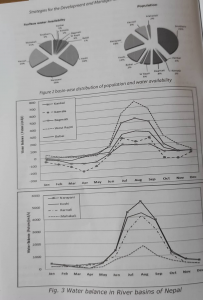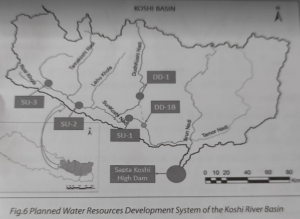-Professor Dr. Narendra Man Shakya
Water Resources Engineering
Institute of Engineering
Tribhuvan University, Nepal
General:
Nepal is endowed with abundant water resources from the availability point of view.
The waters are regarded as the key strategic natural resources having the potential to be the catalyst for all round development and economic growth of the country.
There are about 6000 rivers in Nepal having drainage area of 191000 sq. km, 74 % of which lies in Nepal only.
There are 33 rivers having their drainage areas exceeding 1000 sq. km.
Drainage density expressing the closeness of spacing of channels is about 0.3 km/sq. km.
The development of Nepal’s water resources could generate hydroelectric power, furnish water for irrigation, and supply water for domestic and industrial uses.
River System in Nepal:
Rivers in Nepal can be typically classified into three types depending on their source and discharge.
Mahakali, Karnali, Gandaki and Kosi are four main river systems.
These rivers originate in the Himalayas and carry snow-fed flows with significant discharge even in the dry season.
These rivers are perennial and offer promising water sources for irrigation and hydro power development.
Babai, West Rapti, Bagmati, Kamala, Kankai and Mechi are medium rivers.
These rivers originate in the Midlands or the Mahabharat range.
Rivers of this type are fed by precipitation as well as groundwater regeneration including springs.
These rivers are also perennial but are commonly characterized by a wide seasonal fluctuation in discharge.
In addition to large and medium river systems, there is a large number of small rivers in the Terai, most of which originate from the Siwalik range.
These rivers are seasonal with little flow during the dry season, and unsuitable for year-round irrigation or hydropower generation without surface storage.
The major river basins in Nepal include (from east to West) the Koshi, Kankai, Bagmati, Narayani, Rapti, Babai and Karnali.
Nepalese rivers are characterized by a wide, seasonal fluctuation of flow with the monthly flows generally reaching their maximum in July-August and declining to their minimum in February-March.
About 80 percent of the total flow occurs during five months (June to October) and 20 percent during the remaining months.
It can be generalized that the smaller the size of the river catchment area, the wider is the range of flow fluctuation.
Demand and Supply Situation:
The magnitude of an average availability of the surface and ground water resources of the whole country can be misleading when it comes to its actual utilization.
The variations of water resources availability in terms of time and space are very much different.
To make it even worse, the demands of water for domestic, industrial, irrigation, hydropower generation, environmental requirements etc. do not necessarily match temporally and/or spatially with the available water supply.
This may lead to the resource being categorized as “scarce” rather than abundant in terms of its temporal and spatial variations.
It is seen that around 78% of the average flow of the country is available in the four major basins, 9 % in the medium basins and 13 % in the numerous small southern rivers of the Terai.
As the southern slopes of the Mahabharata, Himalayan range and the eastern two-thirds of the country receive the maximum precipitation, there is more contribution of flow from these catchments.
About 74% of the total annual surface flow occurs in the four months of June-September.
In comparison, 42% of the population resides in the major basins, 18% in the medium and 40% in the Terai region covered by the Southern rivers.
Population is directly related to availability of agriculture lands, requiring irrigation. Irrigation demand is major conjunctive use in a basin.
As illustrated in Figure 2, basin-wise distribution of population and water availability are mismatched in Nepal.

This has resulted in some basins as excessively surplus and some as deficit ones in terms of water availability.
These imbalances become even more inequitable due to perceived climate change in the future.
This makes the planning and management of water resources an additionally complex task.
The water balance in the river basins, if future potential in each basin were to be irrigated, is presented in Figure 3.

It can be seen that the major basins have surplus flow but the medium basins have deficit flow in the dry season.
Existing Water Use:
Although Nepal has 225 BCM of water available annually, only a small part of it (estimated at 15 BCM) has so far been utilized for economic and social purposes.
Out of this, around 95.9% has been used for agriculture, around 3.8% for domestic purpose and only about 0.3% for industry (ADB/ ICIMOD, 2006).
Until now, Nepal has utilized mainly medium and small rivers for different uses such as drinking water, irrigation and hydropower.
The larger and perennial Himalayan Rivers, except for a few run-of-the river schemes, have been virtually left untapped.
Since there is extreme seasonal variation in water availability in the Nepalese rivers, all future programs will have to focus on storage of water during the rainy season and its utilization during dry periods.
Irrigation Potential and Development:
Irrigation is, in many ways, a major factor in the development of Nepal.
It is the largest water use sub-sector, affects the life of many people involved in agriculture, is the major contributor (40%) to the Gross Domestic Product (GDP) (MOF, 2005) and a major factor for maintaining food security in the country.
Most of the schemes in Nepal are supply oriented whose objectives are to distribute irrigation water to the maximum number of farmers.
The design capacity of the canals is low for intensive irrigation (for example the duty of the Sunsari Morang Irrigation Scheme is 0.67 l/s.ha).
The trend is to overestimate the available water in the source and include more area under command due to the social pressure.
The problem is augmented by seepage losses and reduced canal capacity due to sedimentation.
Nepal has a cultivated area of 2,642,000 ha (18% of its land area), of which two thirds (1,766,000 ha) are potentially irrigable.
At present 42% of the cultivated area has irrigation of some sort, but only 17% of cultivated area has year round irrigation (i.e., only 41% of the irrigated area gets year round irrigation).
In the Terai, 82% of the total irrigated area (889,000 ha) is through surface irrigation and the remaining 18% is through groundwater.
Most of the irrigated areas (and the future potential) are situated in the Terai, the fertile lowland. It is estimated that existing irrigation schemes contribute approximately 65% of the country’s current agriculture production (Water and Energy Commission Secretariat, 2003) as compared to the 40% crop output from 18% irrigated land in the world (Schultz, 2002).
To irrigate the remaining area, large-scale multipurpose land and water development projects have to be implemented that need huge investments; otherwise they are economically less viable. Even the developed existing schemes are running far below their target level.
Around 90% of the command area is covered during the wet season while the coverage is only around 25% during the dry season.
This is in fact due to the high seasonal variation of available water in the streams.
Most of the small and medium scale schemes take water from small to medium sized streams and are affected most. The coverage during the dry season is nominal even for large-scale schemes from snow-fed perennial rivers due to design and operational limitations.
Even if the large-scale multipurpose storage and inter-basin river diversion projects were implemented with great urgency over the next twenty-five years, there would still be 55% of the irrigable arable land non-irrigated between November and May in 2025 (Shah and Singh, 2001).
# Second part to be published soon.
#Text courtesy: Association of Former Career Ambassadors of Nepal ( AFCAN) journal on “Strategies for the Development of Nepal’s Water Resources” edited by Dr. Khaga Naath Adhikari.
Published with the permission of the AFCAN President Ambassador Dr. Ram Bhakta Thakur: Ed. Upadhyaya.
Thanks the distinguished author and AFCAN.
Our contact email address is: editor.telegraphnepal@gmail.com

